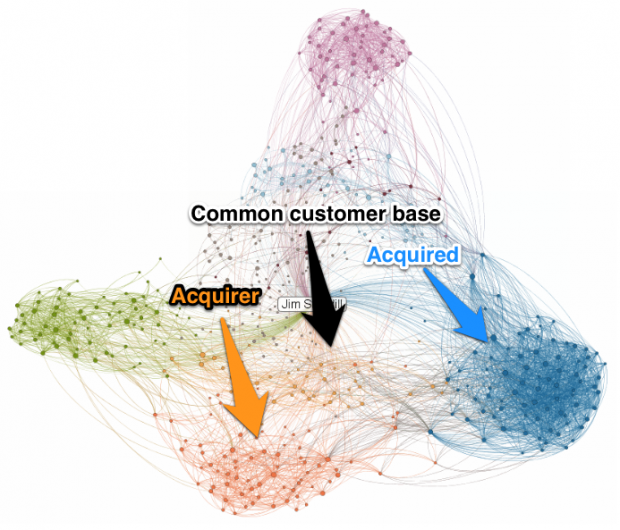- FBI Uses Agile (Information Week) — The FBI awarded the original contract for the case management system to Lockheed Martin in 2006, but an impatient Fulgham, who was hired in 2008 to get the project on track, decided to bring it in house in September 2010. Since then, the agency has been using agile development to push the frequently delayed project across the finish line. The FBI’s agile team creates a software build every two weeks, and the pre-launch system is now running Build 33. The agency is working on Build 36, comprised mainly of features that weren’t part of the original RFP. Fulgham says the software is essentially done.
- Lucky Meat (Matt Webb) — the man is a mad genius. If you believe “mad” and “genius” are opposite ends of a single dimension, then I will let you choose where to place this post on that continuum. Then when you choose your tea (or coffee), the liquid is shot as if through the barrel of a gun BANG directly at your face. We use facial recognition computer chips or something for this. It blasts, and splashes, as hard and fierce as possible. And then the tea (or coffee) is runs down the inside slope of the “V” and is channeled in and falls eventually into a cup at the bottom apex where it finally drips in. Then you have your drink. (But you don’t need it, because you’re already awake.)
- Quietly Awesome — how are your hiring processes biased towards extroverts? See also I don’t hire unlucky people.
- How We Will Read (Clive Thompson) — Clive is my hero. I feel like we see all these articles that say, “This is what the e-book is,” and my response is always, “We have no idea what the e-book is like!” All these design things have yet to be solved and even thought about, and we have history of being really really good at figuring this out. If you think about the origins of the codex — first we started reading on scrolls. Scrolls just pile up, though. You can’t really organize them. Codexes made it easier to line them up on a shelf. But it also meant there were pages. It didn’t occur to them for some time to have page numbers, because the whole idea was that you only read a small number of books and you were going to read them over and over and over again. Once there were so many books that you were going to read a book once and maybe never again, it actually became important to consult the book and be able to find something inside it. So page numbers and indices became important. We look at books and we’re like, “They’re so well designed,” but it took centuries for them to become well-designed. So you look at e-books, and yeah, they’re alright, but they’re clearly horrible compared to what they’re going to be. I find it amazing that I can get this much pleasure out of them already. AMEN!
"experience" entries

Full-stack tensions on the Web
How much do you need to know?
 I expected that CSSDevConf would be primarily a show about front-end work, focused on work in clients and specifically in browsers. I kept running into conversations, though, about the challenges of moving between the front and back end, the client and the server side. Some were from developers suddenly told that they had to become “full-stack developers” covering the whole spectrum, while others were from front-end engineers suddenly finding a flood of back-end developers tinkering with the client side of their applications. “Full-stack” isn’t always a cheerful story.
I expected that CSSDevConf would be primarily a show about front-end work, focused on work in clients and specifically in browsers. I kept running into conversations, though, about the challenges of moving between the front and back end, the client and the server side. Some were from developers suddenly told that they had to become “full-stack developers” covering the whole spectrum, while others were from front-end engineers suddenly finding a flood of back-end developers tinkering with the client side of their applications. “Full-stack” isn’t always a cheerful story.
In the early days of the Web, “full-stack” was normal. While there were certainly people who focused on running web servers or designing sites as beautiful as the technology would allow, there were lots of webmasters who knew how to design a site, write HTML, manage a server, and maybe write some CGI code for early applications.
Formal separation of concerns among HTML, CSS, and JavaScript made it easier to share responsibilities among specialists. As the dot-com boom proceeded, specialization accelerated, with dedicated designers, programmers, and sysadmins coming to the work. Perhaps there were too many titles.
Even as the bust set in, specialization remained the trend because Web projects — especially on the server side — had grown far more complicated. They weren’t just a server and a few scripts, but a complete stack, including templates, logic, and usually a database. Whether you preferred the LAMP stack, a Microsoft ASP stack, or perhaps Java servlets and JSP, the server side rapidly became its own complex arena. Intranet development in particular exploded as a way to build server-based applications that could (cheaply) connect data sources to users on multiple platforms. Writing web apps was faster and cheaper than writing desktop apps, with more tolerance for platform variation.
Read more…

Why isn’t social media more like real life?
You know the graph. Use it to provide a more human experience.
I finally got around to looking at my personal network graph on Linkedin Labs the other day. It was a fun exercise and I got at least one interesting insight from it.
Take a look at these two well defined and distinct clusters in my graph. These are my connections with the startup I worked for (blue) and the company that acquired us in 2008 (orange). It is fascinating to me that all these years later the clusters remain so disconnected. There are shared connections within a common customer base, but very few direct connections across the clusters. I would love to see maps from some of my other colleagues who are still there to see if theirs show the same degree of separation. This was an acquisition that never really seemed to click and whether this is a picture of cause or effect, it maps to my experiences living in it.
That’s an aside though. What this graph really puts in stark relief is what every social network out there is learning about us. And this graph doesn’t really tell the whole story because it doesn’t represent edge weights and types, which they also know. Social networks know who we connect with, who we interact with, and the form and strength of those interactions.
But this post isn’t a privacy rant. I know they know this stuff and so do you. What this image got me thinking about again is why social networks aren’t using this information to create for us a social experience that is more like our real world, and frankly more in tune with our human-ness. Read more…


Four short links: 6 April 2012
Agile FBI, Lucky Meat, Hiring Introverts, and Future of Reading

The dilemma of authentic learning: Do you destroy what you measure?
The challenge of translating the educational benefits of making.
Making and education clearly go hand in hand, but how do we quantify and share the results of authentic learning without losing its essence? That's the issue educators are currently facing.

The end of social
When you take the friction out of sharing, you also remove the value.
If you want to tell me what you listen to, I care. But if sharing is nothing more than a social application feed that's constantly updated without your volition, then it's just another form of spam.

An On-Demand Night at the Opera
The Metropolitan Opera is letting its inner geek run free. Performances will soon be available as pay-per-stream feeds and subscription packages through The Met's Web site. From the New York Times: For $3.99 or $4.99 per streamed opera, users will have a six-hour window in which to listen to or watch a production, once it has started. A monthly…

Reinventing the Book and Killing It are Separate Things
Columnist Richard Cohen is overestimating the threat of digital books.

Rethinking Libraries and Museums as "Living" Structures
The Living Library project flips the reader-book dynamic on its head by allowing library patrons to "check out" human beings, and then engage in a civil dialogue. Nina Simon from Museum 2.0 extends the Living Library structure to a reimagining of museums: How could visitors' stereotypes about museum behavior and the kinds of activities available in museums be exploited to…
